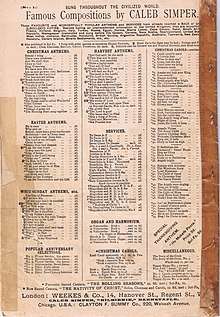Caleb Simper
Caleb Simper (September 12, 1856 – August 28, 1942) was an English composer and church organist. He gained fame for his prolific output of choral and organ works.
Caleb Simper | |
|---|---|
| Born | 12 September 1856 |
| Died | 28 August 1942 (aged 85) |
| Nationality | British |
| Occupation | |

Career
Simper was born in the village of Barford St Martin, Wiltshire, the son of a shoemaker. After a period in Worcester, where he worked in a music shop that was owned by the Elgar family, and as organist and choirmaster at St Mary Magdalene's Church, he moved in the 1890s to Barnstaple where he spent the remainder of his active life working as a composer, and as choirmaster and organist at St Mary Magdalene's Church.
He produced a prodigious amount of Anglican church music and organ pieces, written in an unsophisticated, popular style and aimed at small parish choirs and unskilled organists. Although ignored if not derided by critics, his anthems in particular became widely popular and were sold by his publisher under the slogan "Sung throughout the civilized world". Over five million copies had been sold by the 1920s and a few works remain in print today, though Simper's musical style has long since fallen from fashion.
Amongst Simper's larger works are the cantatas, The Rolling Seasons and The Nativity of Christ. He also wrote somewhere in the region of 200 pieces of organ music and several miscellaneous works such as "The Silver Clarion", a march which exists in a version for organ and a version for pianoforte.
His publisher was A. Weekes and Co. Ltd, whose catalogue was eventually acquired by Stainer & Bell.[1]
Some works were published in tonic sol-fa notation.
Personal life
Around 1897, his address was "Kilbirnie, Barnstaple". As of 2019, the house, at 34, Ashleigh Road, is extant.[2]
Simper's first wife was called Emily.[3] Their son, Roland Chalmers Simper, was also an organist and music teacher.[4] A Private in the British Army's Hertfordshire Regiment, he pre-deceased his father in 1917.[3]
He remarried after Emily's death.
References
- "The Electric Bell: LOVE IT OR LOATHE IT Caleb Simper". The Electric Bell. Stainer & Bell Ltd. 20 February 2013. Retrieved 15 January 2019.
- "34, Ashleigh Road, Barnstaple". Google Street View.
- Roland Chalmers Simper on Lives of the First World War
- "Roland Chalmers Simper". Biographical Dictionary of the Organ. Retrieved 15 January 2019.
Further reading
- Boggis, J.E. (1915). A History of The Parish and Church of St Mary Magdalene, Barnstaple. Canterbury. p. 124.
- Turner, Christopher (1992). Sung Throughout the Civilised World. Devon County Council.
- Gordon, Rumson (13 December 2003). "Gordon Rumson investigates the sacred choral music of Caleb Simper, (no longer) sung throughout the civilized world".
External links
| Wikimedia Commons has media related to Caleb Simper. |
- Free scores by Caleb Simper in the Choral Public Domain Library (ChoralWiki)
- Brian Clegg, "Who was Caleb Simper?" The Church Music Site
- Caleb Simper Preservation Project
Performances
At Gurnos Chapel Ystalyfera Swansea: